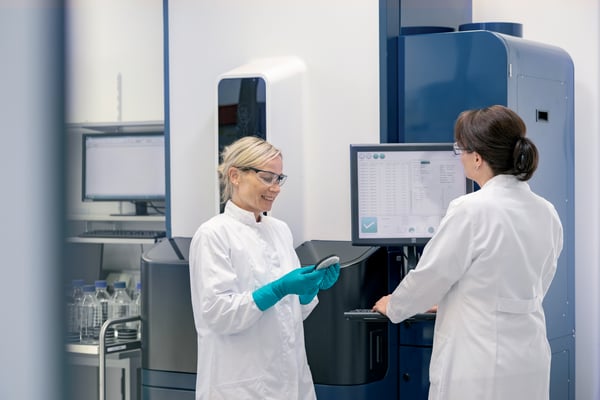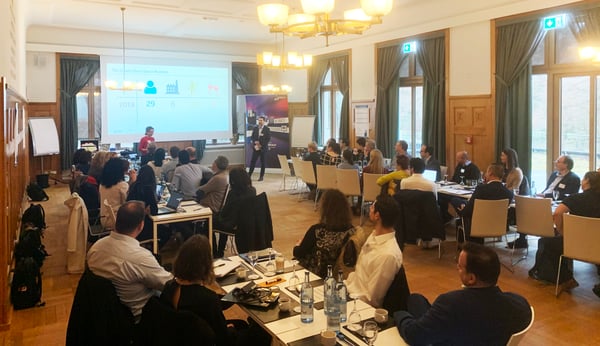blog
February 6, 2020 | Source: Rapid Micro Biosystems, Inc.
Boehringer Ingelheim Hosts 2nd Annual Growth Direct™ Scientific Symposium
POSTED BY Rapid Micro Biosystems | 11 minute read
February 6, 2020 | Source: Rapid Micro Biosystems, Inc.
POSTED BY Rapid Micro Biosystems | 11 minute read
Rapid Micro Biosystems (RMB) were pleased to attend the 2nd Annual Growth Direct™ Users Scientific Symposium hosted by Boehringer Ingelheim in their home city of Bieberach, Germany. This was the second year of the event and attracted more attendees (55) from an expanded group of European companies than the previous year (15).
 Since 2019, BI has relied on the Growth Direct system as an integral part
Since 2019, BI has relied on the Growth Direct system as an integral part
of their business to improve manufacturing and quality processes.
Five presentations were given covering a wide range of topics, but all based around Rapid Micro Methods focusing on rationales for implementation, validation best practices for automated compendial methods and benefits seen when Growth Direct™ was implemented as the routine method.
The first presentation outlined Boehringer Ingelheims’ strategic intent of “Great Quality” of their processes including microbial bioburden testing. One of the main drivers for the goal was to implement new technologies to improve manufacturing and quality processes. Within QC microbiology to address the requirements of data integrity and the regulators increased focus on the manual enumeration of colonies on the media plates and reducing release times. This goal was achieved through implementation of the Growth Direct to automatically incubate and enumerate colonies followed by the electronic transfer to the corporate LIMS system.
The second presentation from RMB described the new automated media manufacturing line. RMB also outlined their new product releases for 2020 and discussed specifics related to the support of our current and future customers in the EU.
The third presentation followed up on the quality discussion and data integrity with a detailed description of their experiences successfully integrating a new electronic lab notebook and the bi-directional implementation of Growth Direct to their Lab Ware LIMS system. The excellent presentation covered many of the Do’s and Don’ts from their experiences. Many of the attendees were in various stages of implementation of LIMS methods as well and will implement relevant aspects of the findings to speed up their own implementation processes. The company has validated the technology for in process samples at their biologics facility and are currently expanding to validate the EM application.
The fourth talk described the approach taken to use a “center of excellence” laboratory to validate the Growth Direct technology for multiple applications, Bioburden for water and In Process and Environmental monitoring. The lab developed a validation procedure to use the central lab to test all the key organisms needed for the development of a suitable Time To Results for the site and to validate the technology as an automated compendial method as defined in the PDA TR 33 and the USP<1223> chapter. The comprehensive testing in the central laboratory allowed the Technical Transfer of the method to other sites within the company and at other locations. The initial validation took about 12-18 months, but the transfer validation process took <6 months. The same process is being used for EM validation. The tech transfer still requires a full IOQ to validate the system however the PQ is significantly reduced to a few test organisms to verify detection is comparable to the first validated system. The TTR is also transferred from the first system and a reduced MQ is performed to verify that there are no unusual organisms to be found at the new site “in the wild”. The technology was validated and in routine use for water initially and is in the process of tech transfer to other sites in the global network.
The fifth talk focused on a perennial problem in Pharma microbiology, what is the optimum incubation temperature and incubation time for environmental monitoring samples. This company also used the approach of a central laboratory performing a full validation for the Growth Direct technology with the generation of a significantly reduced technology transfer roll out to other global sites. This site focused on the EM application on class C and D areas. A full validation compliant with EP 5.1.6 was performed with a time to result study performed on organisms recovered from global sites. The rationale being that this Time to Results (TTR) approach would then be rolled out as being suitable for all sites and just required a short MQ to verify the methods performance. During the investigation of the TTR all organisms were run with the most common incubation strategies currently in use: serial low to high or high to low using 30-35°C and 20-25°C. Both serial methods used 3 days at each temperature. The third incubation used was 25 to 30°C for 6 days. This single temperature strategy is building in interest as it is believed to have a broader organism recovery range and recovers molds that are killed at the 30-35°C incubation. Overall the single incubation at 25 to 30°C range had equivalent performance to the serial methods and gave a Time To Result (TTR) of 3 days. The method validation is being finalized prior to global roll out.
The final presentation covered the validation of the technology for water and in process bioburden testing with a biologic manufacturing process. Validations were performed according the requirements for an automated compendial test. The technology has been in routine used for water testing for 2 years and has been shown to be cost effective with the faster release of water systems to routine use following engineering interventions. For in process testing the technology was validated with a TTR of less than 48 hours and has been included in the BLA for new products for most of the downstream process test points. The company also described a very simple and efficient process for the generic validation of the Growth Direct system and is following that for the validation of the EM application. For EM the company has adopted a single incubation strategy at 30-35° for 3 days.

The final session consisted of a panel discussion with representatives from 5 companies and the manufacturer to answer questions that arose during the day. Topics that were covered included:
1) Preparation and relevance of stressed cells to be included in the validation process. The general consensus was that environmental and water samples are naturally stressed. However, the status of whether organisms were stressed when recovered from commercial lyophilized preparations or whether organisms should be manually stressed was not fully agreed.
2) Regulatory agency audit experience was discussed, and feedback was that the regulators were primarily concerned with good training of staff to fully understand the technology and the way samples are controlled by the system to ensure full data integrity compliance.
3) The topic of verifying if samples that have any contamination should be verified for mold contamination, even if within Alert levels, within C and D was an active discussion point. The majority of the attendees did not perform that test, however for grade A and B any contamination would be identified.
4) Experience with LIMS communication, Time To Results testing and incubation conditions were raised for further clarification of presentations.
Overall the attendees agreed that the day was highly valuable to their understanding of the technology and further confirming the validation strategy and benefits to implement routine testing. The attendees agreed that the EU meeting would be repeated in 2020 and a US version would more than likely be initiated as well.
Related Articles:
A Race Against the Clock: Achieving Fast, Accurate Results in Microbial Contamination Detection
To learn more about Growth Direct™, please visit here.
To speak with someone about how Rapid Micro Biosystems can help your company, please contact us here.